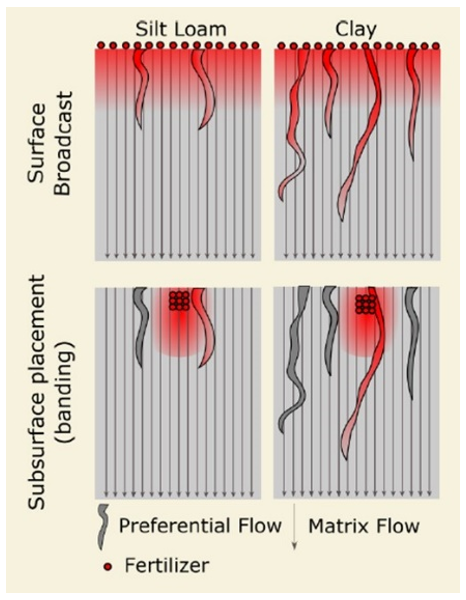Why macropores can ruin your best intentions with conservation practices
Site specific conservation planning is key to managing no-till and cover crops in row crop systems.

The influence of phosphorus loss from agricultural fields on fresh water bodies is a regularly discussed concern in Michigan. Management techniques to prevent phosphorus loss include a variety of in field practices and edge of field modifications. The most common practices to reduce nutrient loss are cover cropping and no-till practices, however research suggests that, in some fields, these practices may not have the intended effect.
Steven Safferman, associate professor and researcher at MSU’s Department of Biosystems and Agricultural Engineering focuses on the fate and transport of nutrients from agricultural land and the potential recovery of such nutrients with a particular interest in phosphorus. “If phosphorus can be managed by keeping it in the root zone and preventing it from leaving fields, it would be a win-win,” Safferman explains, because management and recovery of phosphorus is a win for the environment and an agronomic win. Yet, striking this balance may require more intentional use of conservation practices.
No-Till
Soil high in clay can be a great advantage for capturing and holding nutrients unless you have macropores. Macropores are larger than typical soil pores and are developed from root growth or worm channels. No-till systems on clay soils tend to develop numerous and deep macropores. Such pores can encourage deeper water infiltration, however they can also cause a preferential flow pattern of water into a tile drain with less soil to water contact. This means water, or nutrients, would not travel evenly through the soil profile (see Figure 1).

Macropores are a naturally occurring and essential attribute of soil structure, so determining if phosphorus loss through preferential flow is a concern may require more insight on your field conditions and field location within a watershed. If they may be of concern, managing for this in clay soils can include light tillage (disk or field cultivator) to prevent macropore development. Reducing phosphorus loss can also be done through subsurface placement (or injection) of fertilizers and manure, rather than broadcasting. Considering the form of phosphorus may also make a difference in preventing phosphorus loss. Safferman’s work found that mineral fertilizers were not significantly different from each other in their likelihood of loss (MAP, DAP and TSP) but swine and dairy manure were less mobile than mineral P within the soil column.
Cover Crops
Recent research has found that cover crops may also be a concern for phosphorus loss. Findings have shown that during multiple freeze/thaw events in a winter where temperatures reach -4 degrees Fahrenheit or below with little snow cover, the plant cells of cover crops rupture and release previously captured phosphorus back into the system. This is of particular concern in fields that have shallow tile drains, where this plant-available soluble phosphorus can be rapidly lost. No-till is a practice that would exacerbate this problem by promoting the formation of macropores in some soil types (see Figure 1). Meaning that phosphorus, either applied or stored within cover crops, might be more readily lost in no-till fields under these specific conditions.
Balancing Concerns with Site Specific Planning
Safferman has been conducting further research to determine the field circumstances that make this phenomenon of highest concern in Michigan fields. Knowing whether to apply a practice “is going to be site to site and field to field but under certain circumstances we may not want to use cover crops or no-till practices,” explains Safferman. Safferman wants to remind producers that “the highest priority in any field setting is reducing erosion.” Using cover crops and no-till to prevent nutrient loss works best if erosion is an issue. Knowing your soil types, your weather patterns and your management opinions will also help in making these decisions. Tools like SAIS are helpful in identifying field areas most at risk for erosion loss.
Unfortunately, soluble phosphorus loss in certain conditions may occur regardless of the in-field practices applied due to historic concentrations of phosphorus in some soils and crop growth needs. Because of this, edge of field practices to control and recover phosphorus should be considered such as controlled drainage, saturated buffers or bioreactors. MSU’s Drainage webpage includes many educational materials on these practices.
Site-specific conservation planning is key and there are some general field factors that may help you personalize your tillage and cover crop use:
- You may want to incorporate light tillage using a disk or field cultivator, or manage nutrient application method through injection or subsurface application, timing, and amount if your fields are:
- Quickly drained fields with shallow tiling
- Located in an area with shallow groundwater levels
- High in clay and have a history of no-till
- If you are in an area that reaches -4 F or below with little snow cover, you may want to consider more winter hardy cover crops that are less prone to rupture (such as winter cereal rye, hairy vetch, winter barley)
- Consider forms of applied phosphorus that may be less mobile. Knowing the best cases and timings for manure application can help.

Safferman’s work at MSU has been impactful to support cropping practices for Michigan farmers that keep farming profitable while minimizing our impacts on the surrounding ecosystem. To stay up-to-date on field crop research like this and more, visit the MSU Extension field crop website, Facebook page or podcast



 Print
Print Email
Email